Business Law Report: English Legal System and Case Study
VerifiedAdded on 2020/06/06
|18
|5756
|84
Report
AI Summary
This report provides a comprehensive overview of business law in the UK, focusing on the structure of the English legal system and various sources of law that organizations must adhere to. It explores the roles of government in law-making, differentiating between statutory and common law applications within the justice courts. The report delves into employer's legal obligations, analyzing their impact on businesses through relevant employment and contract law. A case study is used to analyze the impact of regulations, legislation, and standards. Furthermore, the report suggests appropriate legal solutions for business problems, supported by relevant statutes and case precedents. It evaluates the positive and negative impacts of these solutions and explains the concept and benefits of Alternative Dispute Resolution (ADR). The report concludes by comparing and contrasting the effectiveness of different recommendations, offering legal solutions in comparison with alternative legal advice.
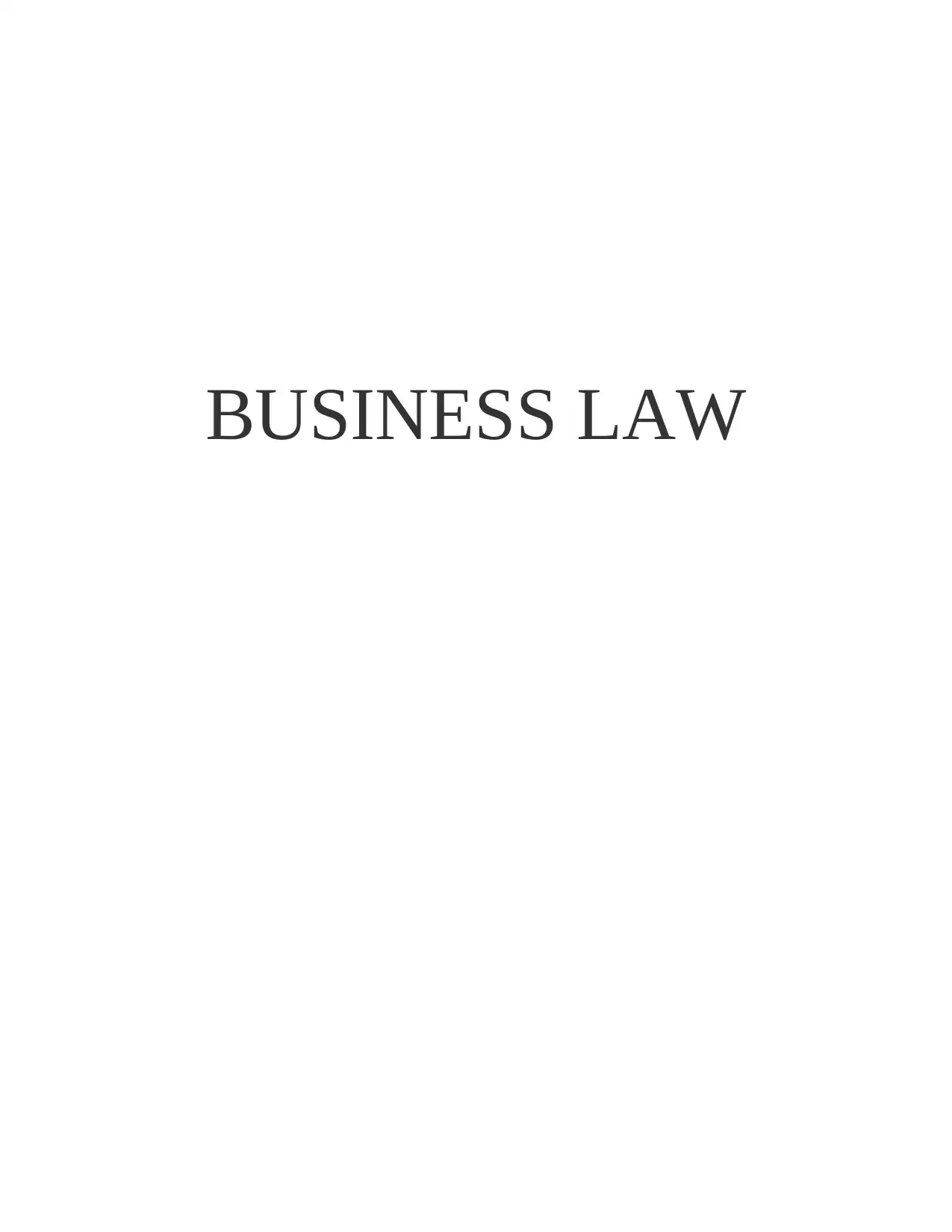
BUSINESS LAW
Paraphrase This Document
Need a fresh take? Get an instant paraphrase of this document with our AI Paraphraser
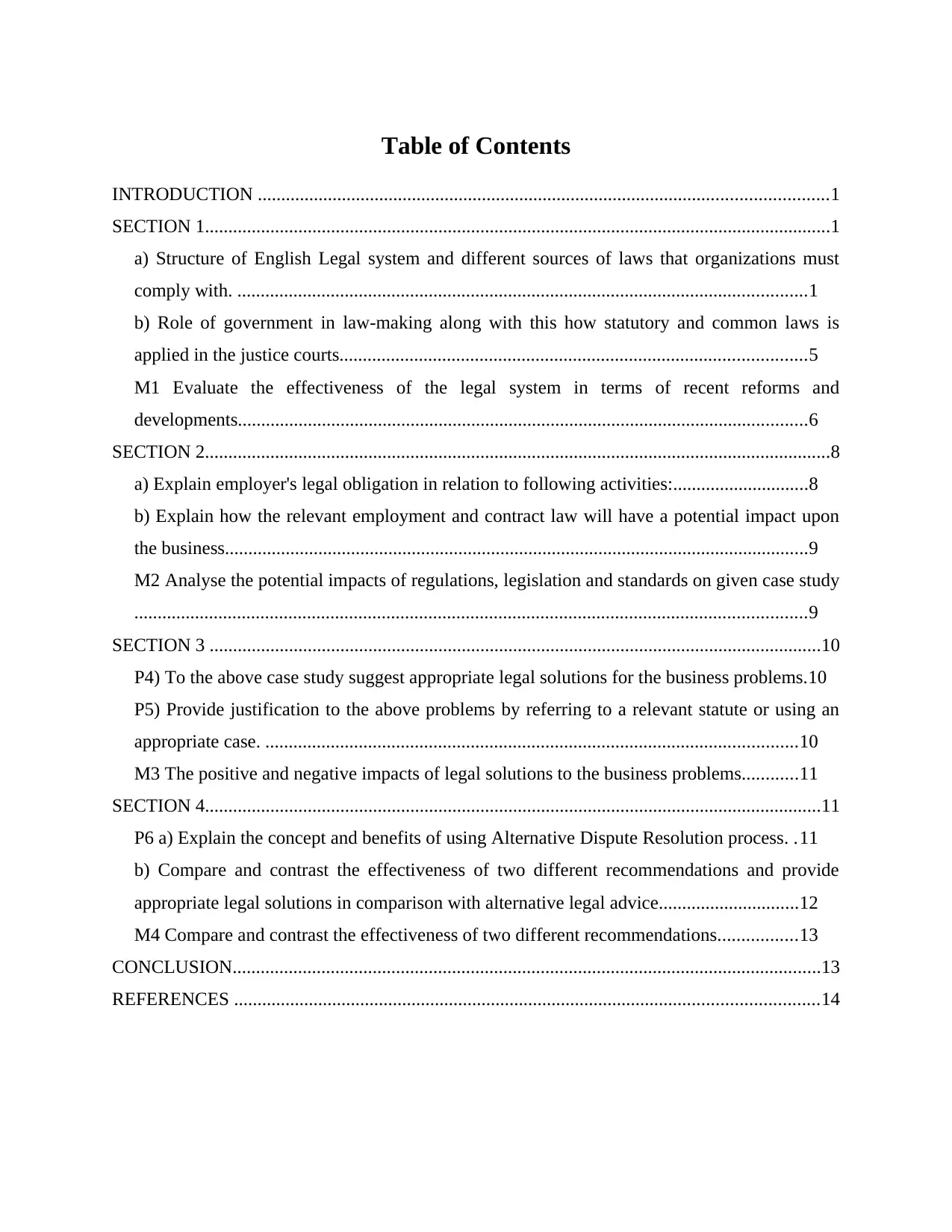
Table of Contents
INTRODUCTION ..........................................................................................................................1
SECTION 1......................................................................................................................................1
a) Structure of English Legal system and different sources of laws that organizations must
comply with. ..........................................................................................................................1
b) Role of government in law-making along with this how statutory and common laws is
applied in the justice courts....................................................................................................5
M1 Evaluate the effectiveness of the legal system in terms of recent reforms and
developments..........................................................................................................................6
SECTION 2......................................................................................................................................8
a) Explain employer's legal obligation in relation to following activities:.............................8
b) Explain how the relevant employment and contract law will have a potential impact upon
the business.............................................................................................................................9
M2 Analyse the potential impacts of regulations, legislation and standards on given case study
................................................................................................................................................9
SECTION 3 ...................................................................................................................................10
P4) To the above case study suggest appropriate legal solutions for the business problems.10
P5) Provide justification to the above problems by referring to a relevant statute or using an
appropriate case. ..................................................................................................................10
M3 The positive and negative impacts of legal solutions to the business problems............11
SECTION 4....................................................................................................................................11
P6 a) Explain the concept and benefits of using Alternative Dispute Resolution process. .11
b) Compare and contrast the effectiveness of two different recommendations and provide
appropriate legal solutions in comparison with alternative legal advice..............................12
M4 Compare and contrast the effectiveness of two different recommendations.................13
CONCLUSION..............................................................................................................................13
REFERENCES .............................................................................................................................14
INTRODUCTION ..........................................................................................................................1
SECTION 1......................................................................................................................................1
a) Structure of English Legal system and different sources of laws that organizations must
comply with. ..........................................................................................................................1
b) Role of government in law-making along with this how statutory and common laws is
applied in the justice courts....................................................................................................5
M1 Evaluate the effectiveness of the legal system in terms of recent reforms and
developments..........................................................................................................................6
SECTION 2......................................................................................................................................8
a) Explain employer's legal obligation in relation to following activities:.............................8
b) Explain how the relevant employment and contract law will have a potential impact upon
the business.............................................................................................................................9
M2 Analyse the potential impacts of regulations, legislation and standards on given case study
................................................................................................................................................9
SECTION 3 ...................................................................................................................................10
P4) To the above case study suggest appropriate legal solutions for the business problems.10
P5) Provide justification to the above problems by referring to a relevant statute or using an
appropriate case. ..................................................................................................................10
M3 The positive and negative impacts of legal solutions to the business problems............11
SECTION 4....................................................................................................................................11
P6 a) Explain the concept and benefits of using Alternative Dispute Resolution process. .11
b) Compare and contrast the effectiveness of two different recommendations and provide
appropriate legal solutions in comparison with alternative legal advice..............................12
M4 Compare and contrast the effectiveness of two different recommendations.................13
CONCLUSION..............................................................................................................................13
REFERENCES .............................................................................................................................14
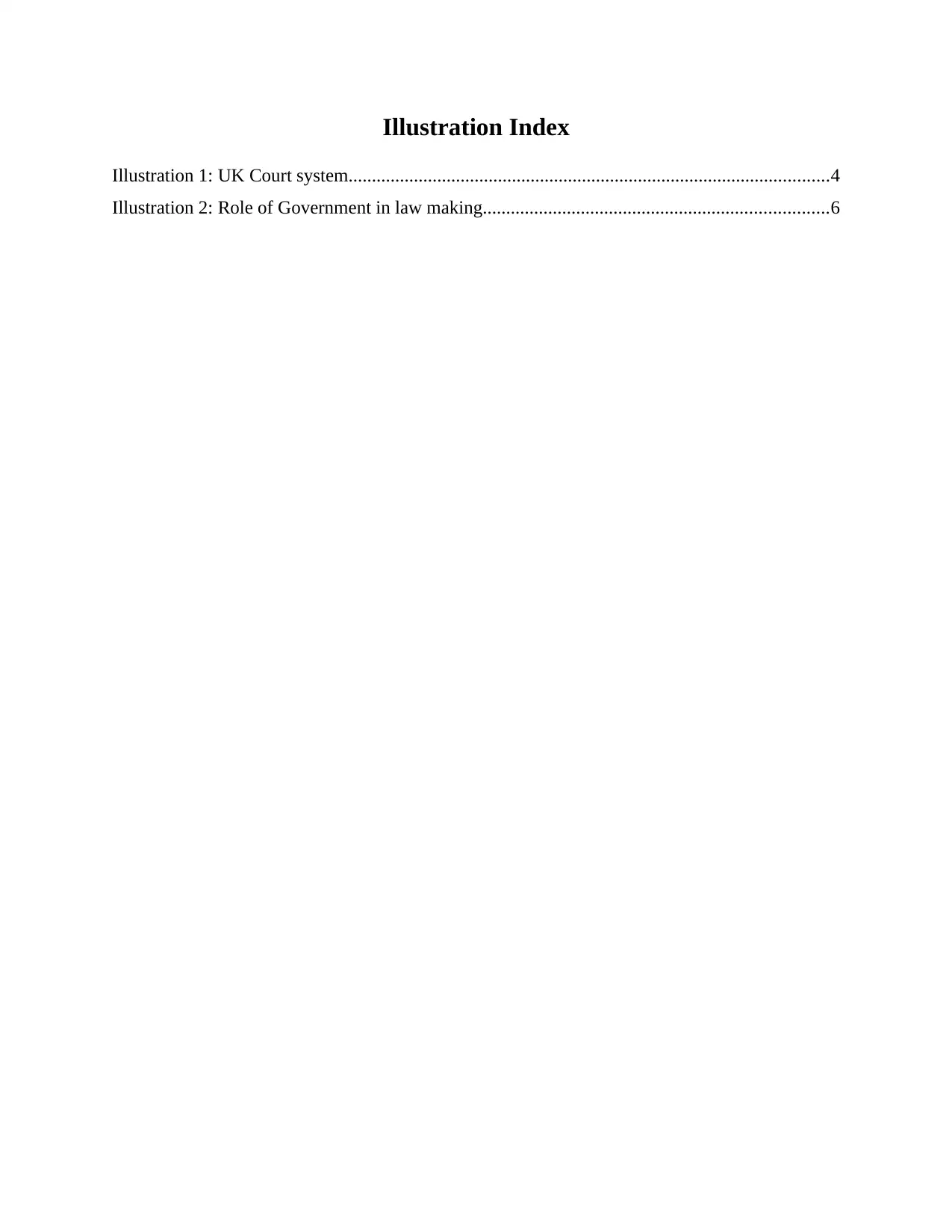
Illustration Index
Illustration 1: UK Court system.......................................................................................................4
Illustration 2: Role of Government in law making..........................................................................6
Illustration 1: UK Court system.......................................................................................................4
Illustration 2: Role of Government in law making..........................................................................6
⊘ This is a preview!⊘
Do you want full access?
Subscribe today to unlock all pages.

Trusted by 1+ million students worldwide
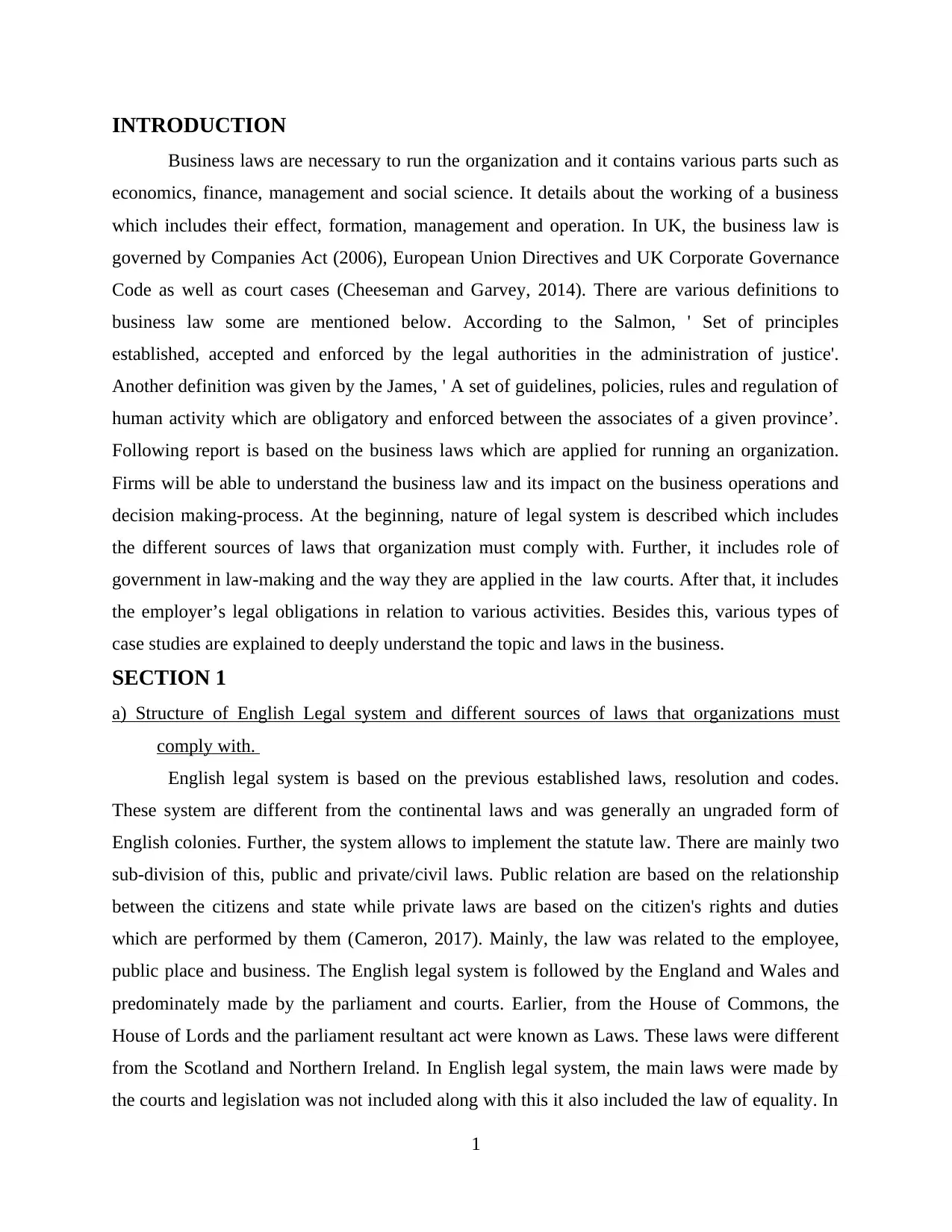
INTRODUCTION
Business laws are necessary to run the organization and it contains various parts such as
economics, finance, management and social science. It details about the working of a business
which includes their effect, formation, management and operation. In UK, the business law is
governed by Companies Act (2006), European Union Directives and UK Corporate Governance
Code as well as court cases (Cheeseman and Garvey, 2014). There are various definitions to
business law some are mentioned below. According to the Salmon, ' Set of principles
established, accepted and enforced by the legal authorities in the administration of justice'.
Another definition was given by the James, ' A set of guidelines, policies, rules and regulation of
human activity which are obligatory and enforced between the associates of a given province’.
Following report is based on the business laws which are applied for running an organization.
Firms will be able to understand the business law and its impact on the business operations and
decision making-process. At the beginning, nature of legal system is described which includes
the different sources of laws that organization must comply with. Further, it includes role of
government in law-making and the way they are applied in the law courts. After that, it includes
the employer’s legal obligations in relation to various activities. Besides this, various types of
case studies are explained to deeply understand the topic and laws in the business.
SECTION 1
a) Structure of English Legal system and different sources of laws that organizations must
comply with.
English legal system is based on the previous established laws, resolution and codes.
These system are different from the continental laws and was generally an ungraded form of
English colonies. Further, the system allows to implement the statute law. There are mainly two
sub-division of this, public and private/civil laws. Public relation are based on the relationship
between the citizens and state while private laws are based on the citizen's rights and duties
which are performed by them (Cameron, 2017). Mainly, the law was related to the employee,
public place and business. The English legal system is followed by the England and Wales and
predominately made by the parliament and courts. Earlier, from the House of Commons, the
House of Lords and the parliament resultant act were known as Laws. These laws were different
from the Scotland and Northern Ireland. In English legal system, the main laws were made by
the courts and legislation was not included along with this it also included the law of equality. In
1
Business laws are necessary to run the organization and it contains various parts such as
economics, finance, management and social science. It details about the working of a business
which includes their effect, formation, management and operation. In UK, the business law is
governed by Companies Act (2006), European Union Directives and UK Corporate Governance
Code as well as court cases (Cheeseman and Garvey, 2014). There are various definitions to
business law some are mentioned below. According to the Salmon, ' Set of principles
established, accepted and enforced by the legal authorities in the administration of justice'.
Another definition was given by the James, ' A set of guidelines, policies, rules and regulation of
human activity which are obligatory and enforced between the associates of a given province’.
Following report is based on the business laws which are applied for running an organization.
Firms will be able to understand the business law and its impact on the business operations and
decision making-process. At the beginning, nature of legal system is described which includes
the different sources of laws that organization must comply with. Further, it includes role of
government in law-making and the way they are applied in the law courts. After that, it includes
the employer’s legal obligations in relation to various activities. Besides this, various types of
case studies are explained to deeply understand the topic and laws in the business.
SECTION 1
a) Structure of English Legal system and different sources of laws that organizations must
comply with.
English legal system is based on the previous established laws, resolution and codes.
These system are different from the continental laws and was generally an ungraded form of
English colonies. Further, the system allows to implement the statute law. There are mainly two
sub-division of this, public and private/civil laws. Public relation are based on the relationship
between the citizens and state while private laws are based on the citizen's rights and duties
which are performed by them (Cameron, 2017). Mainly, the law was related to the employee,
public place and business. The English legal system is followed by the England and Wales and
predominately made by the parliament and courts. Earlier, from the House of Commons, the
House of Lords and the parliament resultant act were known as Laws. These laws were different
from the Scotland and Northern Ireland. In English legal system, the main laws were made by
the courts and legislation was not included along with this it also included the law of equality. In
1
Paraphrase This Document
Need a fresh take? Get an instant paraphrase of this document with our AI Paraphraser
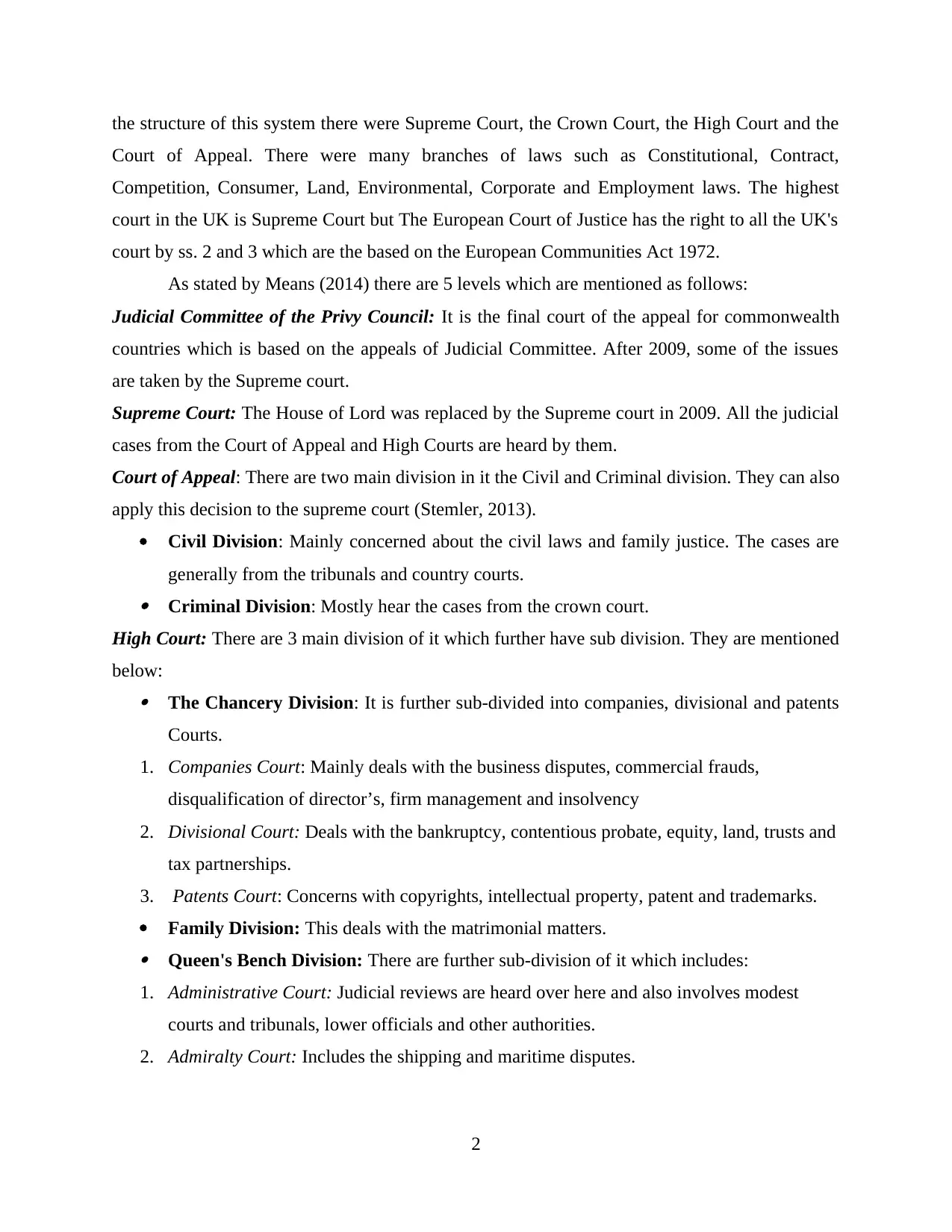
the structure of this system there were Supreme Court, the Crown Court, the High Court and the
Court of Appeal. There were many branches of laws such as Constitutional, Contract,
Competition, Consumer, Land, Environmental, Corporate and Employment laws. The highest
court in the UK is Supreme Court but The European Court of Justice has the right to all the UK's
court by ss. 2 and 3 which are the based on the European Communities Act 1972.
As stated by Means (2014) there are 5 levels which are mentioned as follows:
Judicial Committee of the Privy Council: It is the final court of the appeal for commonwealth
countries which is based on the appeals of Judicial Committee. After 2009, some of the issues
are taken by the Supreme court.
Supreme Court: The House of Lord was replaced by the Supreme court in 2009. All the judicial
cases from the Court of Appeal and High Courts are heard by them.
Court of Appeal: There are two main division in it the Civil and Criminal division. They can also
apply this decision to the supreme court (Stemler, 2013).
Civil Division: Mainly concerned about the civil laws and family justice. The cases are
generally from the tribunals and country courts. Criminal Division: Mostly hear the cases from the crown court.
High Court: There are 3 main division of it which further have sub division. They are mentioned
below: The Chancery Division: It is further sub-divided into companies, divisional and patents
Courts.
1. Companies Court: Mainly deals with the business disputes, commercial frauds,
disqualification of director’s, firm management and insolvency
2. Divisional Court: Deals with the bankruptcy, contentious probate, equity, land, trusts and
tax partnerships.
3. Patents Court: Concerns with copyrights, intellectual property, patent and trademarks.
Family Division: This deals with the matrimonial matters. Queen's Bench Division: There are further sub-division of it which includes:
1. Administrative Court: Judicial reviews are heard over here and also involves modest
courts and tribunals, lower officials and other authorities.
2. Admiralty Court: Includes the shipping and maritime disputes.
2
Court of Appeal. There were many branches of laws such as Constitutional, Contract,
Competition, Consumer, Land, Environmental, Corporate and Employment laws. The highest
court in the UK is Supreme Court but The European Court of Justice has the right to all the UK's
court by ss. 2 and 3 which are the based on the European Communities Act 1972.
As stated by Means (2014) there are 5 levels which are mentioned as follows:
Judicial Committee of the Privy Council: It is the final court of the appeal for commonwealth
countries which is based on the appeals of Judicial Committee. After 2009, some of the issues
are taken by the Supreme court.
Supreme Court: The House of Lord was replaced by the Supreme court in 2009. All the judicial
cases from the Court of Appeal and High Courts are heard by them.
Court of Appeal: There are two main division in it the Civil and Criminal division. They can also
apply this decision to the supreme court (Stemler, 2013).
Civil Division: Mainly concerned about the civil laws and family justice. The cases are
generally from the tribunals and country courts. Criminal Division: Mostly hear the cases from the crown court.
High Court: There are 3 main division of it which further have sub division. They are mentioned
below: The Chancery Division: It is further sub-divided into companies, divisional and patents
Courts.
1. Companies Court: Mainly deals with the business disputes, commercial frauds,
disqualification of director’s, firm management and insolvency
2. Divisional Court: Deals with the bankruptcy, contentious probate, equity, land, trusts and
tax partnerships.
3. Patents Court: Concerns with copyrights, intellectual property, patent and trademarks.
Family Division: This deals with the matrimonial matters. Queen's Bench Division: There are further sub-division of it which includes:
1. Administrative Court: Judicial reviews are heard over here and also involves modest
courts and tribunals, lower officials and other authorities.
2. Admiralty Court: Includes the shipping and maritime disputes.
2
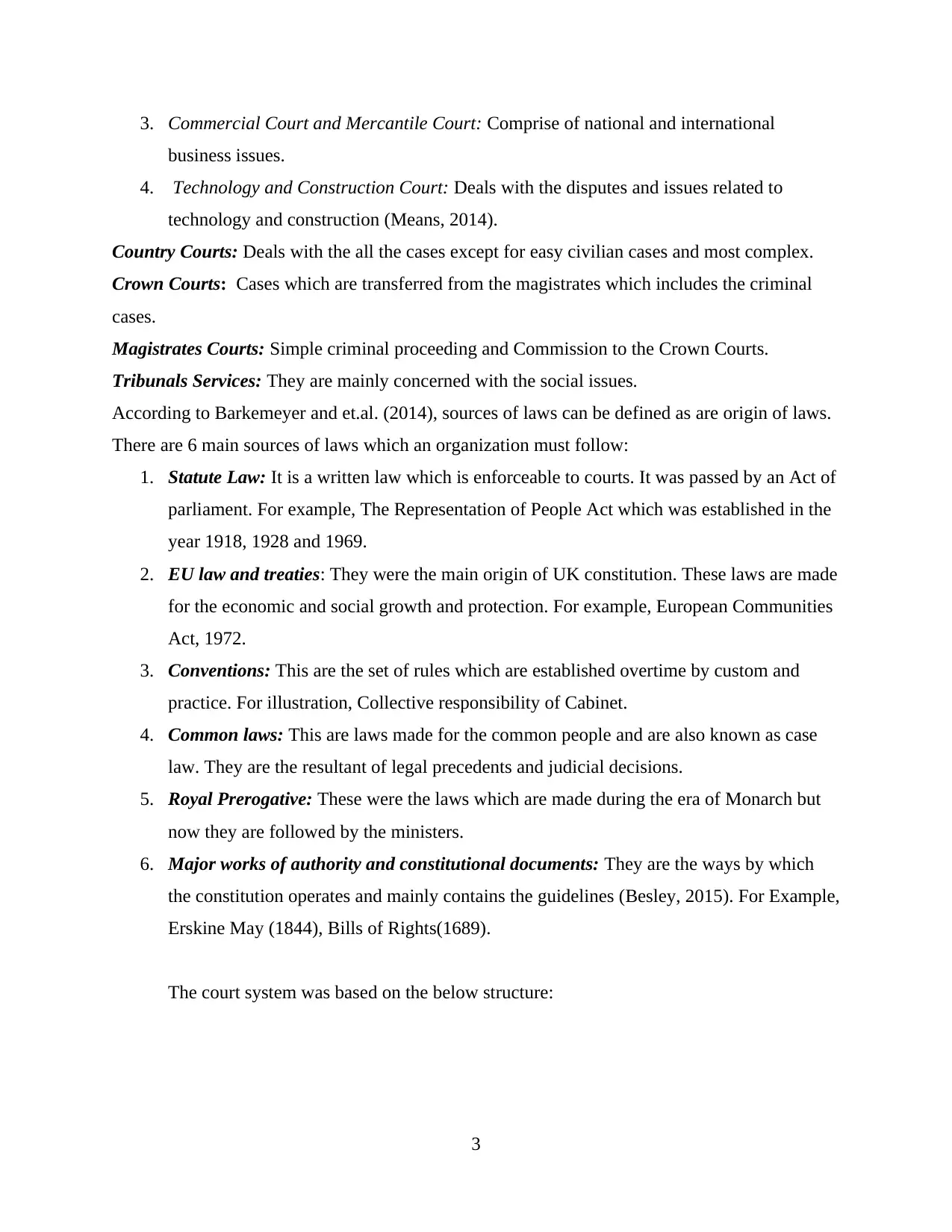
3. Commercial Court and Mercantile Court: Comprise of national and international
business issues.
4. Technology and Construction Court: Deals with the disputes and issues related to
technology and construction (Means, 2014).
Country Courts: Deals with the all the cases except for easy civilian cases and most complex.
Crown Courts: Cases which are transferred from the magistrates which includes the criminal
cases.
Magistrates Courts: Simple criminal proceeding and Commission to the Crown Courts.
Tribunals Services: They are mainly concerned with the social issues.
According to Barkemeyer and et.al. (2014), sources of laws can be defined as are origin of laws.
There are 6 main sources of laws which an organization must follow:
1. Statute Law: It is a written law which is enforceable to courts. It was passed by an Act of
parliament. For example, The Representation of People Act which was established in the
year 1918, 1928 and 1969.
2. EU law and treaties: They were the main origin of UK constitution. These laws are made
for the economic and social growth and protection. For example, European Communities
Act, 1972.
3. Conventions: This are the set of rules which are established overtime by custom and
practice. For illustration, Collective responsibility of Cabinet.
4. Common laws: This are laws made for the common people and are also known as case
law. They are the resultant of legal precedents and judicial decisions.
5. Royal Prerogative: These were the laws which are made during the era of Monarch but
now they are followed by the ministers.
6. Major works of authority and constitutional documents: They are the ways by which
the constitution operates and mainly contains the guidelines (Besley, 2015). For Example,
Erskine May (1844), Bills of Rights(1689).
The court system was based on the below structure:
3
business issues.
4. Technology and Construction Court: Deals with the disputes and issues related to
technology and construction (Means, 2014).
Country Courts: Deals with the all the cases except for easy civilian cases and most complex.
Crown Courts: Cases which are transferred from the magistrates which includes the criminal
cases.
Magistrates Courts: Simple criminal proceeding and Commission to the Crown Courts.
Tribunals Services: They are mainly concerned with the social issues.
According to Barkemeyer and et.al. (2014), sources of laws can be defined as are origin of laws.
There are 6 main sources of laws which an organization must follow:
1. Statute Law: It is a written law which is enforceable to courts. It was passed by an Act of
parliament. For example, The Representation of People Act which was established in the
year 1918, 1928 and 1969.
2. EU law and treaties: They were the main origin of UK constitution. These laws are made
for the economic and social growth and protection. For example, European Communities
Act, 1972.
3. Conventions: This are the set of rules which are established overtime by custom and
practice. For illustration, Collective responsibility of Cabinet.
4. Common laws: This are laws made for the common people and are also known as case
law. They are the resultant of legal precedents and judicial decisions.
5. Royal Prerogative: These were the laws which are made during the era of Monarch but
now they are followed by the ministers.
6. Major works of authority and constitutional documents: They are the ways by which
the constitution operates and mainly contains the guidelines (Besley, 2015). For Example,
Erskine May (1844), Bills of Rights(1689).
The court system was based on the below structure:
3
⊘ This is a preview!⊘
Do you want full access?
Subscribe today to unlock all pages.

Trusted by 1+ million students worldwide
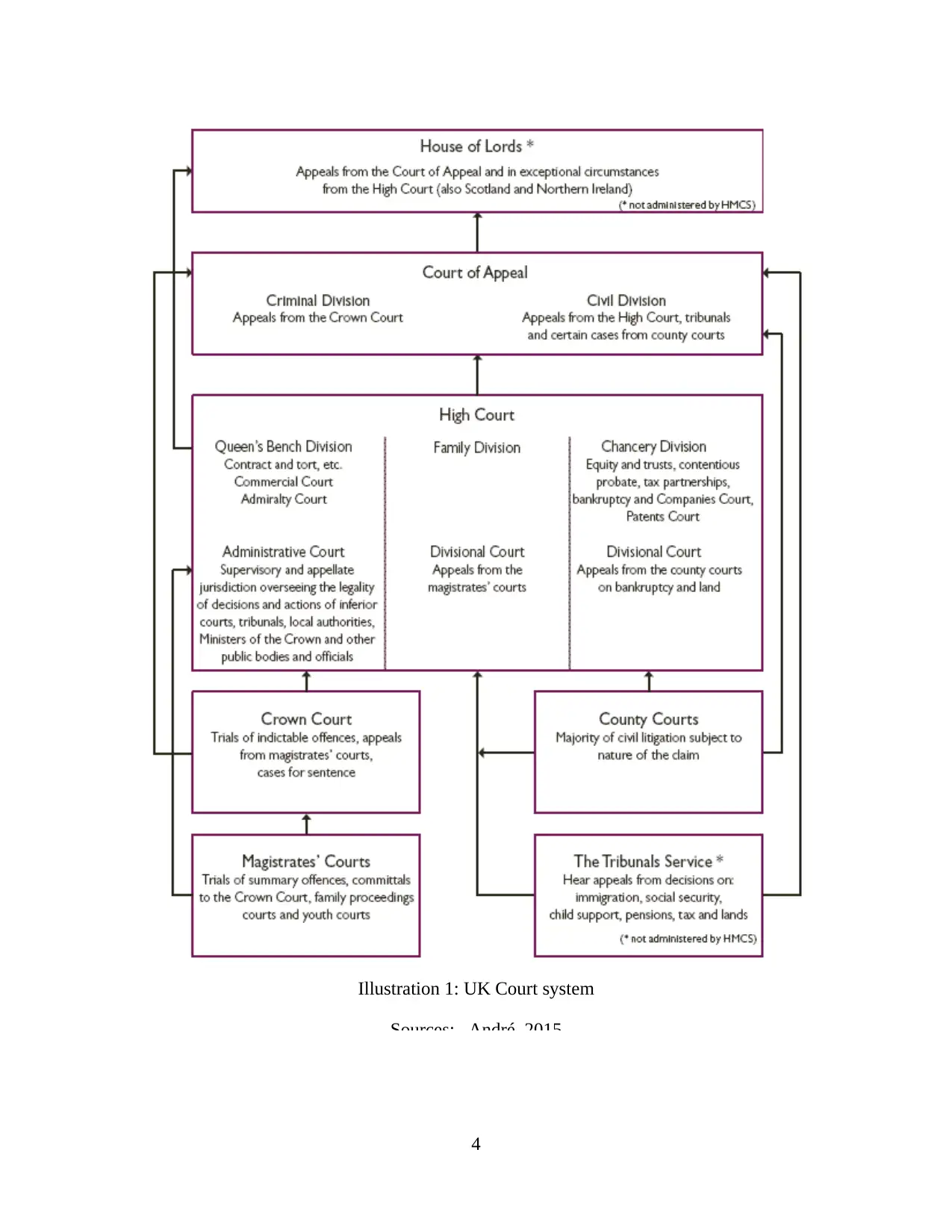
4
Illustration 1: UK Court system
Sources: André, 2015
Illustration 1: UK Court system
Sources: André, 2015
Paraphrase This Document
Need a fresh take? Get an instant paraphrase of this document with our AI Paraphraser
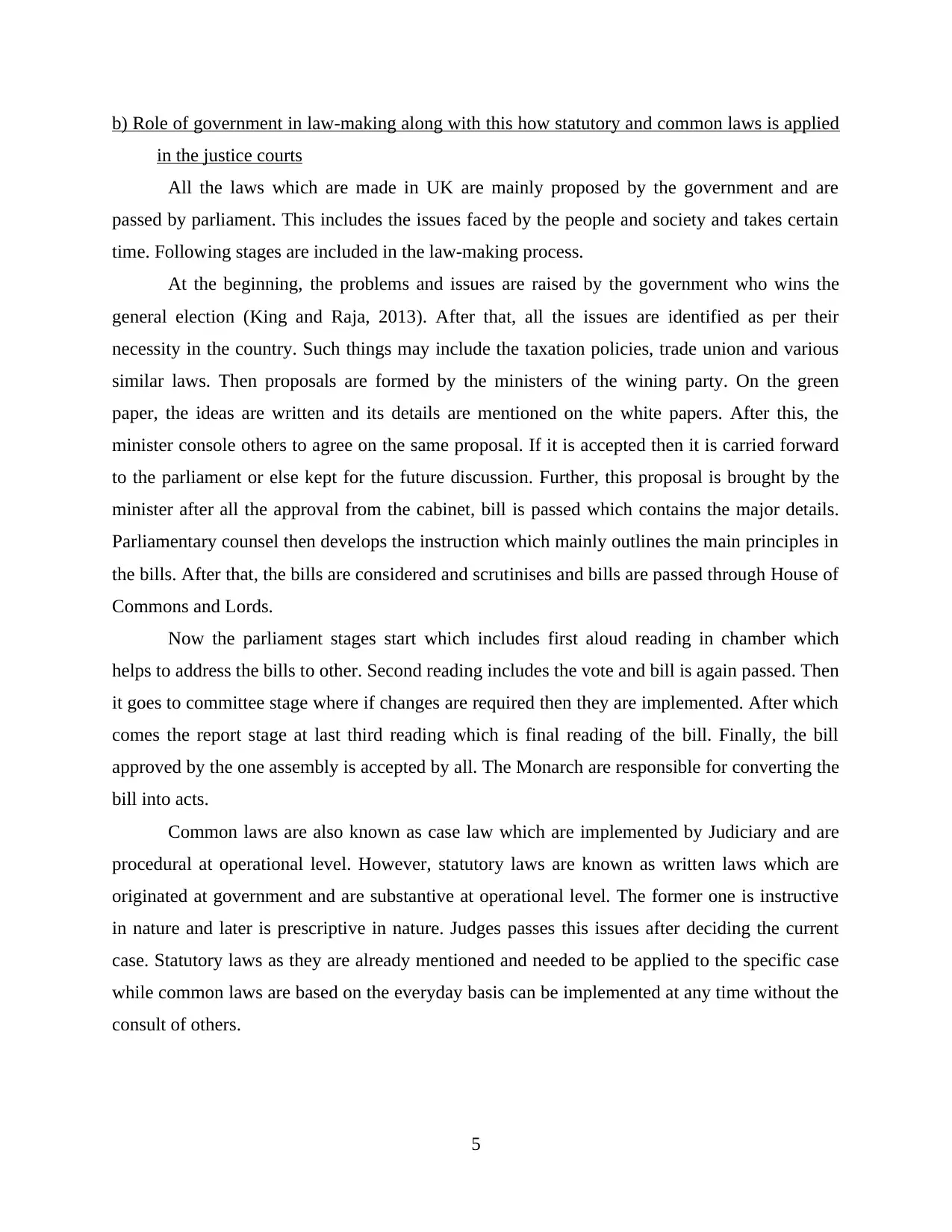
b) Role of government in law-making along with this how statutory and common laws is applied
in the justice courts
All the laws which are made in UK are mainly proposed by the government and are
passed by parliament. This includes the issues faced by the people and society and takes certain
time. Following stages are included in the law-making process.
At the beginning, the problems and issues are raised by the government who wins the
general election (King and Raja, 2013). After that, all the issues are identified as per their
necessity in the country. Such things may include the taxation policies, trade union and various
similar laws. Then proposals are formed by the ministers of the wining party. On the green
paper, the ideas are written and its details are mentioned on the white papers. After this, the
minister console others to agree on the same proposal. If it is accepted then it is carried forward
to the parliament or else kept for the future discussion. Further, this proposal is brought by the
minister after all the approval from the cabinet, bill is passed which contains the major details.
Parliamentary counsel then develops the instruction which mainly outlines the main principles in
the bills. After that, the bills are considered and scrutinises and bills are passed through House of
Commons and Lords.
Now the parliament stages start which includes first aloud reading in chamber which
helps to address the bills to other. Second reading includes the vote and bill is again passed. Then
it goes to committee stage where if changes are required then they are implemented. After which
comes the report stage at last third reading which is final reading of the bill. Finally, the bill
approved by the one assembly is accepted by all. The Monarch are responsible for converting the
bill into acts.
Common laws are also known as case law which are implemented by Judiciary and are
procedural at operational level. However, statutory laws are known as written laws which are
originated at government and are substantive at operational level. The former one is instructive
in nature and later is prescriptive in nature. Judges passes this issues after deciding the current
case. Statutory laws as they are already mentioned and needed to be applied to the specific case
while common laws are based on the everyday basis can be implemented at any time without the
consult of others.
5
in the justice courts
All the laws which are made in UK are mainly proposed by the government and are
passed by parliament. This includes the issues faced by the people and society and takes certain
time. Following stages are included in the law-making process.
At the beginning, the problems and issues are raised by the government who wins the
general election (King and Raja, 2013). After that, all the issues are identified as per their
necessity in the country. Such things may include the taxation policies, trade union and various
similar laws. Then proposals are formed by the ministers of the wining party. On the green
paper, the ideas are written and its details are mentioned on the white papers. After this, the
minister console others to agree on the same proposal. If it is accepted then it is carried forward
to the parliament or else kept for the future discussion. Further, this proposal is brought by the
minister after all the approval from the cabinet, bill is passed which contains the major details.
Parliamentary counsel then develops the instruction which mainly outlines the main principles in
the bills. After that, the bills are considered and scrutinises and bills are passed through House of
Commons and Lords.
Now the parliament stages start which includes first aloud reading in chamber which
helps to address the bills to other. Second reading includes the vote and bill is again passed. Then
it goes to committee stage where if changes are required then they are implemented. After which
comes the report stage at last third reading which is final reading of the bill. Finally, the bill
approved by the one assembly is accepted by all. The Monarch are responsible for converting the
bill into acts.
Common laws are also known as case law which are implemented by Judiciary and are
procedural at operational level. However, statutory laws are known as written laws which are
originated at government and are substantive at operational level. The former one is instructive
in nature and later is prescriptive in nature. Judges passes this issues after deciding the current
case. Statutory laws as they are already mentioned and needed to be applied to the specific case
while common laws are based on the everyday basis can be implemented at any time without the
consult of others.
5
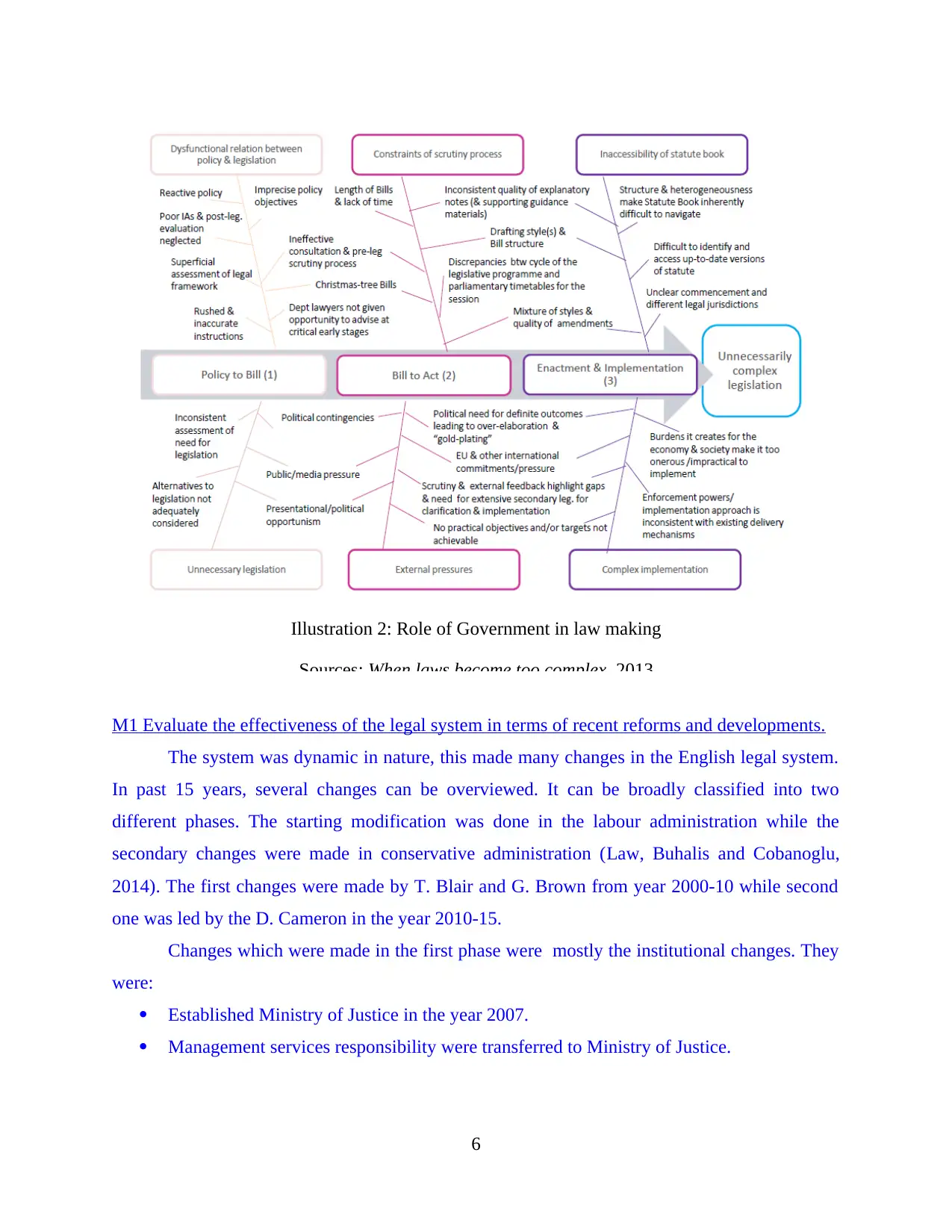
M1 Evaluate the effectiveness of the legal system in terms of recent reforms and developments.
The system was dynamic in nature, this made many changes in the English legal system.
In past 15 years, several changes can be overviewed. It can be broadly classified into two
different phases. The starting modification was done in the labour administration while the
secondary changes were made in conservative administration (Law, Buhalis and Cobanoglu,
2014). The first changes were made by T. Blair and G. Brown from year 2000-10 while second
one was led by the D. Cameron in the year 2010-15.
Changes which were made in the first phase were mostly the institutional changes. They
were:
Established Ministry of Justice in the year 2007.
Management services responsibility were transferred to Ministry of Justice.
6
Illustration 2: Role of Government in law making
Sources: When laws become too complex, 2013
The system was dynamic in nature, this made many changes in the English legal system.
In past 15 years, several changes can be overviewed. It can be broadly classified into two
different phases. The starting modification was done in the labour administration while the
secondary changes were made in conservative administration (Law, Buhalis and Cobanoglu,
2014). The first changes were made by T. Blair and G. Brown from year 2000-10 while second
one was led by the D. Cameron in the year 2010-15.
Changes which were made in the first phase were mostly the institutional changes. They
were:
Established Ministry of Justice in the year 2007.
Management services responsibility were transferred to Ministry of Justice.
6
Illustration 2: Role of Government in law making
Sources: When laws become too complex, 2013
⊘ This is a preview!⊘
Do you want full access?
Subscribe today to unlock all pages.

Trusted by 1+ million students worldwide
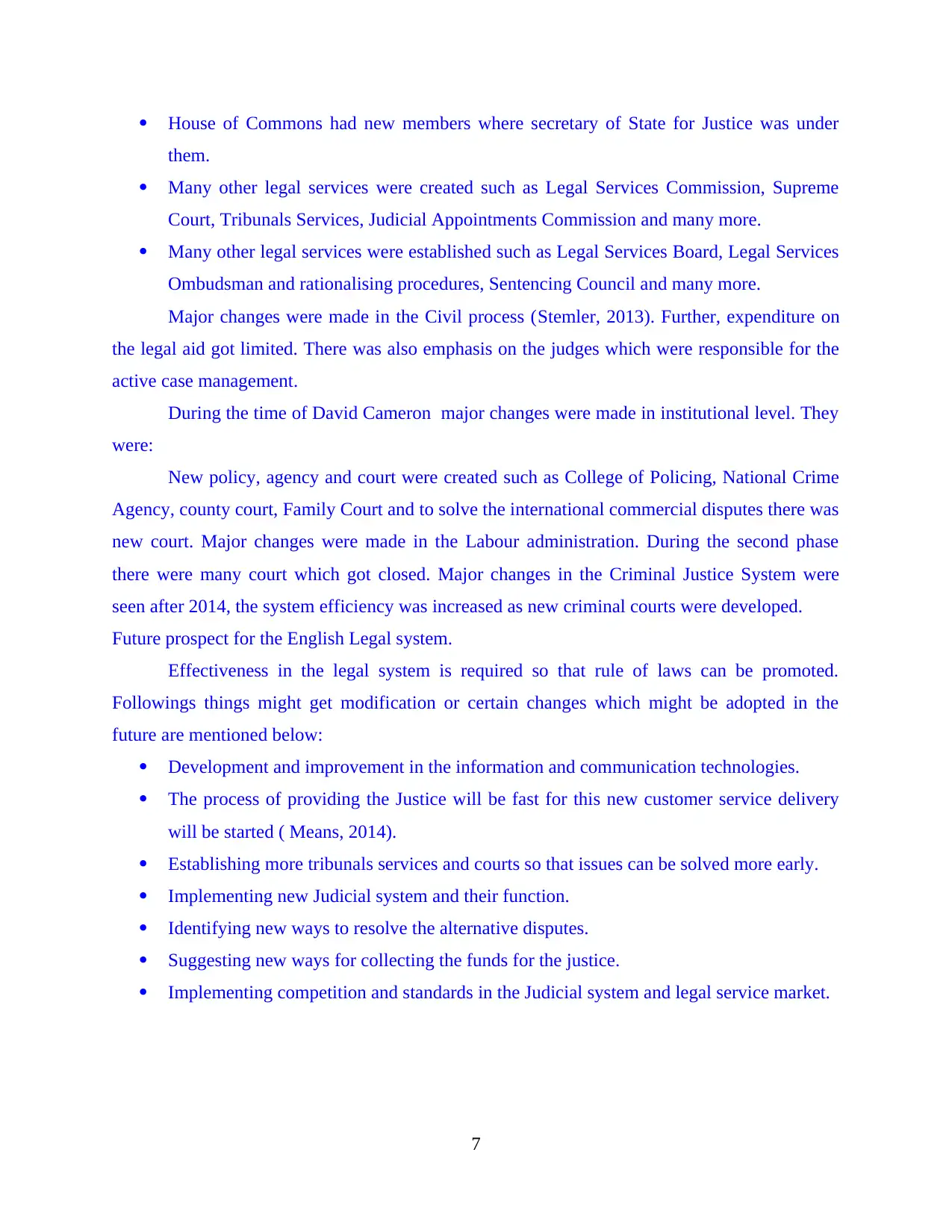
House of Commons had new members where secretary of State for Justice was under
them.
Many other legal services were created such as Legal Services Commission, Supreme
Court, Tribunals Services, Judicial Appointments Commission and many more.
Many other legal services were established such as Legal Services Board, Legal Services
Ombudsman and rationalising procedures, Sentencing Council and many more.
Major changes were made in the Civil process (Stemler, 2013). Further, expenditure on
the legal aid got limited. There was also emphasis on the judges which were responsible for the
active case management.
During the time of David Cameron major changes were made in institutional level. They
were:
New policy, agency and court were created such as College of Policing, National Crime
Agency, county court, Family Court and to solve the international commercial disputes there was
new court. Major changes were made in the Labour administration. During the second phase
there were many court which got closed. Major changes in the Criminal Justice System were
seen after 2014, the system efficiency was increased as new criminal courts were developed.
Future prospect for the English Legal system.
Effectiveness in the legal system is required so that rule of laws can be promoted.
Followings things might get modification or certain changes which might be adopted in the
future are mentioned below:
Development and improvement in the information and communication technologies.
The process of providing the Justice will be fast for this new customer service delivery
will be started ( Means, 2014).
Establishing more tribunals services and courts so that issues can be solved more early.
Implementing new Judicial system and their function.
Identifying new ways to resolve the alternative disputes.
Suggesting new ways for collecting the funds for the justice.
Implementing competition and standards in the Judicial system and legal service market.
7
them.
Many other legal services were created such as Legal Services Commission, Supreme
Court, Tribunals Services, Judicial Appointments Commission and many more.
Many other legal services were established such as Legal Services Board, Legal Services
Ombudsman and rationalising procedures, Sentencing Council and many more.
Major changes were made in the Civil process (Stemler, 2013). Further, expenditure on
the legal aid got limited. There was also emphasis on the judges which were responsible for the
active case management.
During the time of David Cameron major changes were made in institutional level. They
were:
New policy, agency and court were created such as College of Policing, National Crime
Agency, county court, Family Court and to solve the international commercial disputes there was
new court. Major changes were made in the Labour administration. During the second phase
there were many court which got closed. Major changes in the Criminal Justice System were
seen after 2014, the system efficiency was increased as new criminal courts were developed.
Future prospect for the English Legal system.
Effectiveness in the legal system is required so that rule of laws can be promoted.
Followings things might get modification or certain changes which might be adopted in the
future are mentioned below:
Development and improvement in the information and communication technologies.
The process of providing the Justice will be fast for this new customer service delivery
will be started ( Means, 2014).
Establishing more tribunals services and courts so that issues can be solved more early.
Implementing new Judicial system and their function.
Identifying new ways to resolve the alternative disputes.
Suggesting new ways for collecting the funds for the justice.
Implementing competition and standards in the Judicial system and legal service market.
7
Paraphrase This Document
Need a fresh take? Get an instant paraphrase of this document with our AI Paraphraser
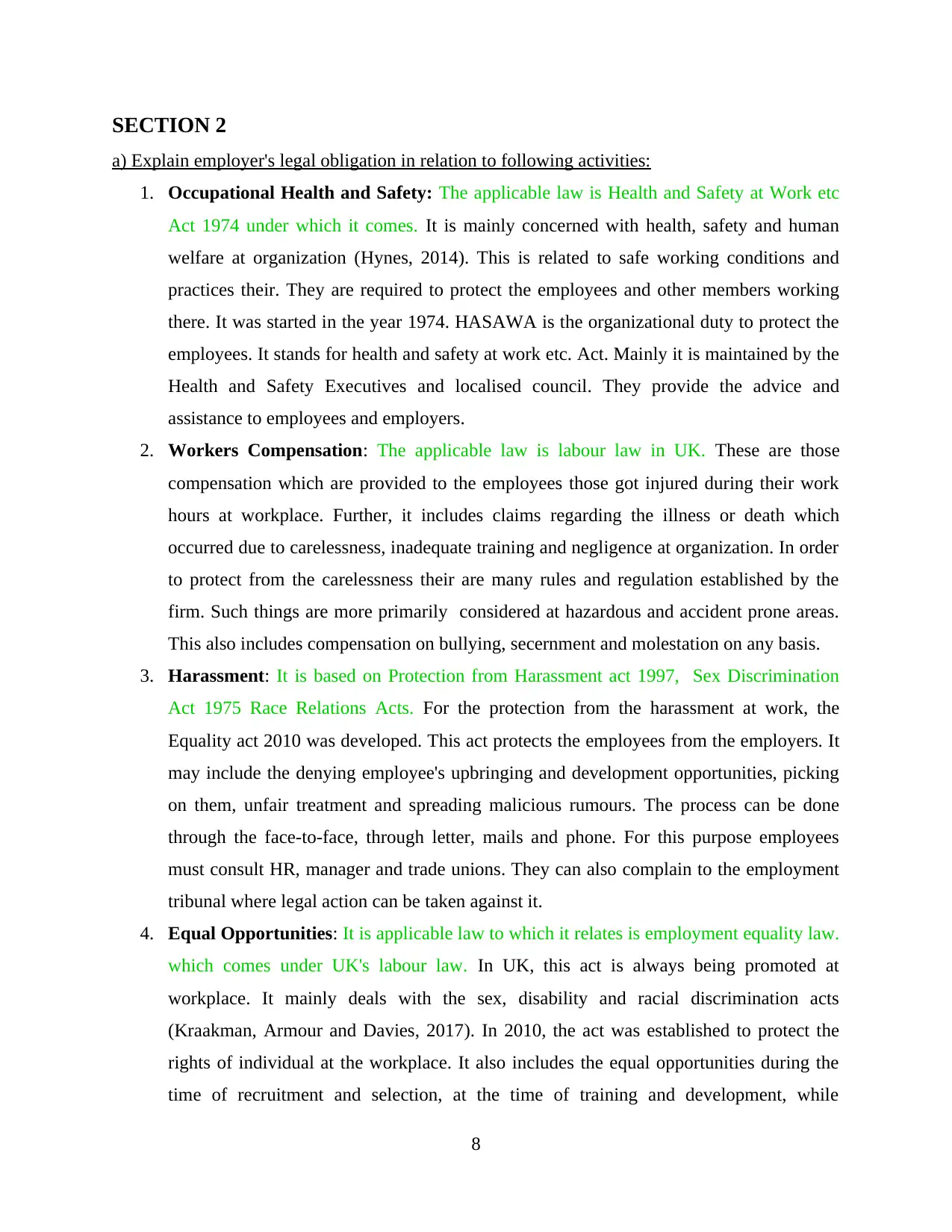
SECTION 2
a) Explain employer's legal obligation in relation to following activities:
1. Occupational Health and Safety: The applicable law is Health and Safety at Work etc
Act 1974 under which it comes. It is mainly concerned with health, safety and human
welfare at organization (Hynes, 2014). This is related to safe working conditions and
practices their. They are required to protect the employees and other members working
there. It was started in the year 1974. HASAWA is the organizational duty to protect the
employees. It stands for health and safety at work etc. Act. Mainly it is maintained by the
Health and Safety Executives and localised council. They provide the advice and
assistance to employees and employers.
2. Workers Compensation: The applicable law is labour law in UK. These are those
compensation which are provided to the employees those got injured during their work
hours at workplace. Further, it includes claims regarding the illness or death which
occurred due to carelessness, inadequate training and negligence at organization. In order
to protect from the carelessness their are many rules and regulation established by the
firm. Such things are more primarily considered at hazardous and accident prone areas.
This also includes compensation on bullying, secernment and molestation on any basis.
3. Harassment: It is based on Protection from Harassment act 1997, Sex Discrimination
Act 1975 Race Relations Acts. For the protection from the harassment at work, the
Equality act 2010 was developed. This act protects the employees from the employers. It
may include the denying employee's upbringing and development opportunities, picking
on them, unfair treatment and spreading malicious rumours. The process can be done
through the face-to-face, through letter, mails and phone. For this purpose employees
must consult HR, manager and trade unions. They can also complain to the employment
tribunal where legal action can be taken against it.
4. Equal Opportunities: It is applicable law to which it relates is employment equality law.
which comes under UK's labour law. In UK, this act is always being promoted at
workplace. It mainly deals with the sex, disability and racial discrimination acts
(Kraakman, Armour and Davies, 2017). In 2010, the act was established to protect the
rights of individual at the workplace. It also includes the equal opportunities during the
time of recruitment and selection, at the time of training and development, while
8
a) Explain employer's legal obligation in relation to following activities:
1. Occupational Health and Safety: The applicable law is Health and Safety at Work etc
Act 1974 under which it comes. It is mainly concerned with health, safety and human
welfare at organization (Hynes, 2014). This is related to safe working conditions and
practices their. They are required to protect the employees and other members working
there. It was started in the year 1974. HASAWA is the organizational duty to protect the
employees. It stands for health and safety at work etc. Act. Mainly it is maintained by the
Health and Safety Executives and localised council. They provide the advice and
assistance to employees and employers.
2. Workers Compensation: The applicable law is labour law in UK. These are those
compensation which are provided to the employees those got injured during their work
hours at workplace. Further, it includes claims regarding the illness or death which
occurred due to carelessness, inadequate training and negligence at organization. In order
to protect from the carelessness their are many rules and regulation established by the
firm. Such things are more primarily considered at hazardous and accident prone areas.
This also includes compensation on bullying, secernment and molestation on any basis.
3. Harassment: It is based on Protection from Harassment act 1997, Sex Discrimination
Act 1975 Race Relations Acts. For the protection from the harassment at work, the
Equality act 2010 was developed. This act protects the employees from the employers. It
may include the denying employee's upbringing and development opportunities, picking
on them, unfair treatment and spreading malicious rumours. The process can be done
through the face-to-face, through letter, mails and phone. For this purpose employees
must consult HR, manager and trade unions. They can also complain to the employment
tribunal where legal action can be taken against it.
4. Equal Opportunities: It is applicable law to which it relates is employment equality law.
which comes under UK's labour law. In UK, this act is always being promoted at
workplace. It mainly deals with the sex, disability and racial discrimination acts
(Kraakman, Armour and Davies, 2017). In 2010, the act was established to protect the
rights of individual at the workplace. It also includes the equal opportunities during the
time of recruitment and selection, at the time of training and development, while
8
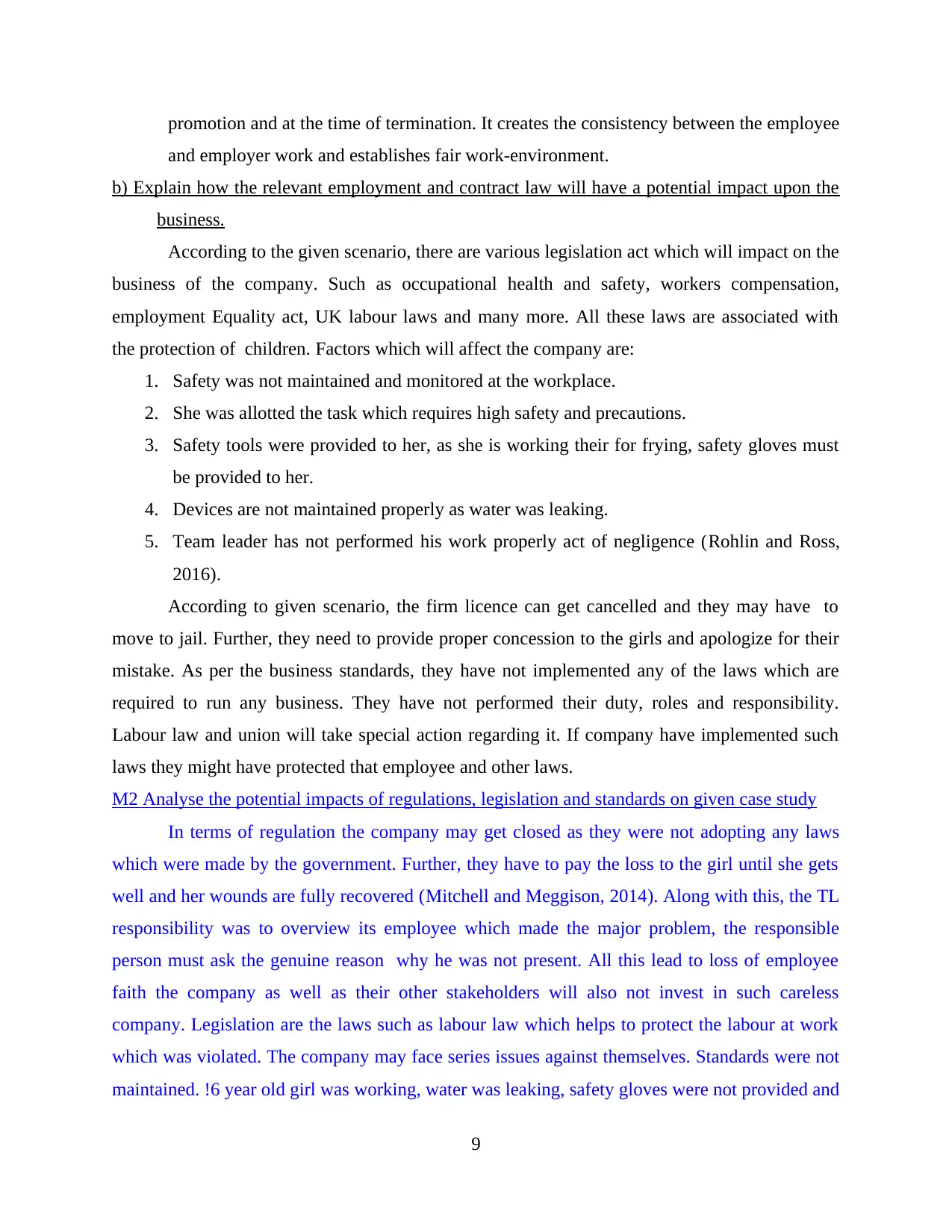
promotion and at the time of termination. It creates the consistency between the employee
and employer work and establishes fair work-environment.
b) Explain how the relevant employment and contract law will have a potential impact upon the
business.
According to the given scenario, there are various legislation act which will impact on the
business of the company. Such as occupational health and safety, workers compensation,
employment Equality act, UK labour laws and many more. All these laws are associated with
the protection of children. Factors which will affect the company are:
1. Safety was not maintained and monitored at the workplace.
2. She was allotted the task which requires high safety and precautions.
3. Safety tools were provided to her, as she is working their for frying, safety gloves must
be provided to her.
4. Devices are not maintained properly as water was leaking.
5. Team leader has not performed his work properly act of negligence (Rohlin and Ross,
2016).
According to given scenario, the firm licence can get cancelled and they may have to
move to jail. Further, they need to provide proper concession to the girls and apologize for their
mistake. As per the business standards, they have not implemented any of the laws which are
required to run any business. They have not performed their duty, roles and responsibility.
Labour law and union will take special action regarding it. If company have implemented such
laws they might have protected that employee and other laws.
M2 Analyse the potential impacts of regulations, legislation and standards on given case study
In terms of regulation the company may get closed as they were not adopting any laws
which were made by the government. Further, they have to pay the loss to the girl until she gets
well and her wounds are fully recovered (Mitchell and Meggison, 2014). Along with this, the TL
responsibility was to overview its employee which made the major problem, the responsible
person must ask the genuine reason why he was not present. All this lead to loss of employee
faith the company as well as their other stakeholders will also not invest in such careless
company. Legislation are the laws such as labour law which helps to protect the labour at work
which was violated. The company may face series issues against themselves. Standards were not
maintained. !6 year old girl was working, water was leaking, safety gloves were not provided and
9
and employer work and establishes fair work-environment.
b) Explain how the relevant employment and contract law will have a potential impact upon the
business.
According to the given scenario, there are various legislation act which will impact on the
business of the company. Such as occupational health and safety, workers compensation,
employment Equality act, UK labour laws and many more. All these laws are associated with
the protection of children. Factors which will affect the company are:
1. Safety was not maintained and monitored at the workplace.
2. She was allotted the task which requires high safety and precautions.
3. Safety tools were provided to her, as she is working their for frying, safety gloves must
be provided to her.
4. Devices are not maintained properly as water was leaking.
5. Team leader has not performed his work properly act of negligence (Rohlin and Ross,
2016).
According to given scenario, the firm licence can get cancelled and they may have to
move to jail. Further, they need to provide proper concession to the girls and apologize for their
mistake. As per the business standards, they have not implemented any of the laws which are
required to run any business. They have not performed their duty, roles and responsibility.
Labour law and union will take special action regarding it. If company have implemented such
laws they might have protected that employee and other laws.
M2 Analyse the potential impacts of regulations, legislation and standards on given case study
In terms of regulation the company may get closed as they were not adopting any laws
which were made by the government. Further, they have to pay the loss to the girl until she gets
well and her wounds are fully recovered (Mitchell and Meggison, 2014). Along with this, the TL
responsibility was to overview its employee which made the major problem, the responsible
person must ask the genuine reason why he was not present. All this lead to loss of employee
faith the company as well as their other stakeholders will also not invest in such careless
company. Legislation are the laws such as labour law which helps to protect the labour at work
which was violated. The company may face series issues against themselves. Standards were not
maintained. !6 year old girl was working, water was leaking, safety gloves were not provided and
9
⊘ This is a preview!⊘
Do you want full access?
Subscribe today to unlock all pages.

Trusted by 1+ million students worldwide
1 out of 18
Related Documents
Your All-in-One AI-Powered Toolkit for Academic Success.
+13062052269
info@desklib.com
Available 24*7 on WhatsApp / Email
![[object Object]](/_next/static/media/star-bottom.7253800d.svg)
Unlock your academic potential
Copyright © 2020–2025 A2Z Services. All Rights Reserved. Developed and managed by ZUCOL.




